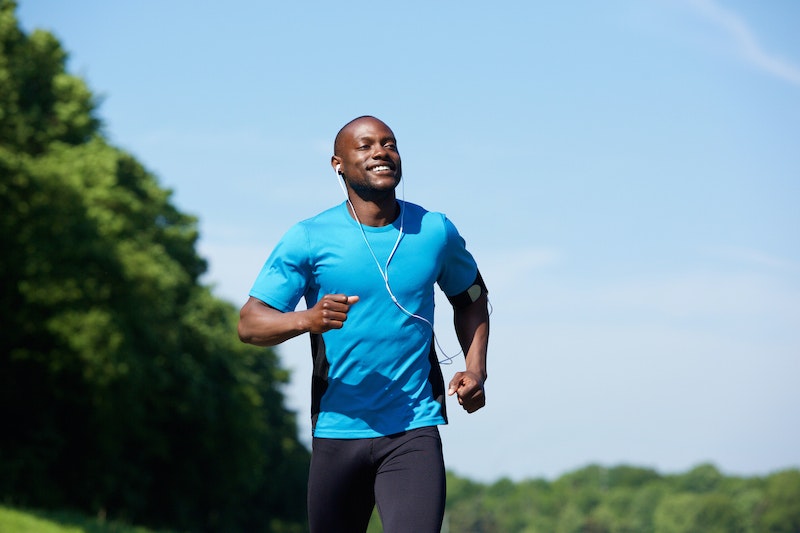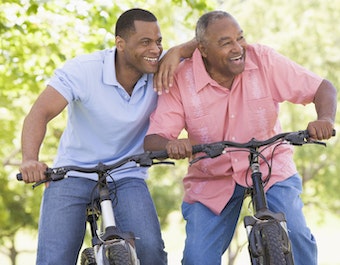If exercise were a drug, it would almost be too good to be true. Of course it can help with weight loss –– in burning calories, and in temporarily suppressing appetite. But the benefits don’t stop there. Activity can also help manage or prevent a wide range of health concerns, from Type 2 diabetes and high blood pressure to depression and many types of cancer. If that wasn’t enough, getting your heart pounding can boost your mood and improve your sleep, too.
Of course, it’s always a good idea to talk to your doctor before starting a new exercise regime, especially if you have a recent or chronic condition. To get into a groove, start slow and gradually add more activity.
Here are just some of the ways exercise does the body good –– inside and out.
Rejuvenate Your Joints
“Exercise is the standard of care to maintain healthy joints,” says Richard Willy, an assistant professor of rehabilitation science at the University of Montana. “No medicine or surgery can come close to the benefits of regular exercise.” Joints do best with a mix of steady weight-bearing aerobic exercise (walking counts!), plus strength training.
Exercise also gently works synovial fluid –– which provides the cushion for joints –– in and out of the cartilage, providing nutrition and lubrication that makes the cartilage stronger and more resilient, says Willy, who is also a physical therapist. (On the flip side, complete rest deprives the cartilage of lubrication, making it brittle over time, Willy says, yet another reason to keep moving.)
For those who already have achy joints, from arthritis for example, try choosing joint-friendly activities, like walking, bicycling, water aerobics, or dancing.
Boost Your Brain
You’ve probably heard that the brain is a muscle. It’s not, technically, but, like a muscle, it responds to exercise. In fact, the relationship between brain health and physical activity is so significant that it was a focus of the U.S. government’s 2018 update of its Physical Activity Guidelines.
Three of the most consistently reported benefits? Improvements in cognitive tasks, improved mood, and a decrease in stress level, according to a 2017 review of studies published in the journal Brain Plasticity.
Exercise can also help you sleep better. Researchers aren’t sure how, exactly, only that activity may increase slow-wave or deep sleep, which helps the body rejuvenate.
There’s also some limited evidence that exercise may improve long-term memory. A small study published earlier this year in Brain Plasticity found that people who did six months of aerobic exercise, like treadmill walking for 150 minutes per week, in keeping with the government’s physical activity guidelines, improved their brain glucose metabolism, a measure of neuronal health, and performed better on higher-order thinking tasks such as planning and mental flexibility.
Heal Your Heart
A review of more than 300 studies published in the American Heart Association’s journal Circulation earlier this year found that physically active people such as regular walkers have up to 50% reduced risk of heart attack and sudden cardiac death. That makes sense, because the cardiovascular benefits of exercise are well known.
One reason has to do with the organ’s structure: Our tickers are made up of four chambers: the left and right atria, and the left and right ventricles. The left ventricle pumps freshly oxygenated blood out of the heart into the rest of the body for use. Regular activity makes the left ventricle slightly bigger –– which makes it easier for the heart to do its job.
Exercise can also lower blood pressure, as well as boost our levels of high-density lipoprotein, or HDL, “good” cholesterol that sucks up and carries cholesterol from other parts of the body to the liver to be removed. Pretty cool.
Soothe Your Skin
Looking for the fountain of youth? Exercise might be the next best thing. Moving your body helps improve circulation, allowing blood to deliver nutrients to the skin and give you that fabulous post-workout “glow.”
It also sweeps away free radicals and other potentially damaging chemicals, says S. Tyler Hollmig, MD, director of dermatologic surgery at the Dell Medical School at the University of Texas. Added to that, there’s limited evidence that exercise may stimulate enzymes that increase collagen growth.
Sweating may be good for the skin, too, Hollmig says. When you perspire, your skin is hydrated, then exfoliated, as salt and other minerals settle atop the skin, and are then removed, Hollmig said. (Note that this works only if you wash your face after exercising –– otherwise you’ll risk an acne flare-up!)
Build Your Bones
Two categories of exercise promote healthy bones: High-impact weight-bearing exercise and strength training. (High-impact weight-bearing activities include things like dancing, jumping rope, high-impact aerobics, and stair climbing; strength training generally means lifting weights, though sometimes, as with pushups or lunges, it’s just your own body weight doing the job.)
Both types of exercise stress the bones (a good thing!), stimulating the development of osteoblasts, cells that build bones back up. If you’re new to exercise or have already been diagnosed with bone loss, you’ll want to talk with your doctor before starting any high-impact weight-bearing exercise routine.
If those sorts of activities are off-limits for you, try walking. While it doesn’t appear to improve bone mass, it can limit loss, according to a 2018 review of studies published in Biomedical Research International.
How Much Exercise Do I Need, Anyway?
Current US guidelines call for at least 150 minutes per week of moderate-intensity activity exercise, or at least 75 minutes of vigorous exercise, preferably spread throughout the week. Two sessions a week should include strength-training involving all major muscle groups.
Want to Work Out Harder?
Put together a pump-you-up playlist. Researchers are still untangling the relationship between music and exercise, but a small 2020 study published in Frontiers in Psychology found that up-tempo tunes both reduced participants’ perceived rate of exertion –– how hard they thought they were working out –– and got their hearts beating faster during activity. Listen to songs that clock in around 170 to 190 beats per minute. Think Elton John’s “I’m Still Standing,” or Taylor Swift’s “Bad Blood,” if Tay’s more your style.





